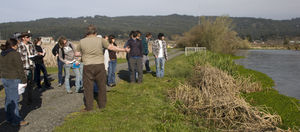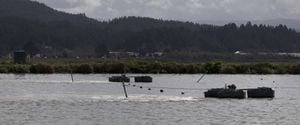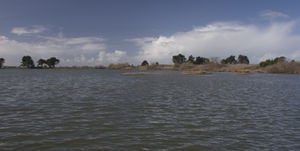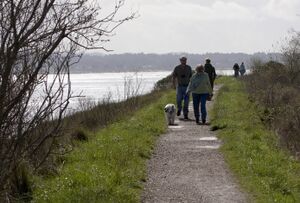Arcata Marsh trails

Arcata Marsh and Wildlife Sanctuary Trails

The Arcata Marsh and Wildlife Sanctuary is a unique marsh where the community and tourists can come and enjoy its benefits. Visitors can learn about:
- The Arcata Wastewater Treatment Plant
- How the natural environment can be implemented to treat wastewater
Two examples of how the natural environment can be used to treat wastewater are the treatment wetlands and the enhancement marshes.
Visitors can also enjoy the beautiful trails and scenery that the Arcata Marsh and Wildlife Sanctuary have to offer as seen in Figure 2.
There are a variety of different activities that the Arcata Marsh and Wildlife Sanctuary offers to the general public such as:
- hiking
- biking
- jogging
- dog walking
- birding
FOAM (Friends of the Arcata Marsh) have an Arcata Marsh and Wildlife Sanctuary Interpretive Center located at 569 South G Street in Arcata, California.[1] The interpretative center is open Monday from 1 to 5 p.m., Tuesday-Sunday from 9 a.m. to 5 p.m. and is closed on all major holidays. This interpretative center's trained docents educate the public about the Arcata Marsh and Wildlife Sanctuary.
The interpretative center is also home to many exhibits including exhibits on:
- The history of the Arcata Marsh and Wildlife Sanctuary
- The biological processes that are a part of the Arcata Marsh and Wildlife Sanctuary
Above, in Figure 1 shows a group tour of students learning about the processes of the Arcata Wastewater Treatment Plant. Group tours can be arranged through the Arcata Marsh and Wildlife Sanctuary Interpretative Center. There is a free public tour every Sunday at 2 p.m. all year long that leaves from the interpretative center.
To contact the Arcata Marsh and Wildlife Interpretative Center call (707)-826-2359.[2]
Arcata Marsh and Wildlife Sanctuary Trails Guide[edit | edit source]

Any combination of the 4.5 miles of trails at the Arcata Marsh and Wildlife Sanctuary are enjoyable.[3]The trails are accessible during the given hours of use. The weekend between the hours of 8 a.m. and 3 p.m. are the most popular times to visit the Arcata Marsh and Wildlife Sanctuary due to offered nature walks such as the Audubon Nature Walk. This walk meets every Saturday at 8:30 a.m. at the last parking lot located on South I Street in Arcata, California.[4] Depending on your interest, there are a variety of things that can be seen at the Arcata Marsh and Wildlife Sanctuary. Such as:
- How the natural environment is used to treat wastewater
- How the Arcata Marsh and Wildlife Sanctuary serves as a home to many different species of animals
- Some history of old Arcata
Figure 3 is the Arcata Marsh and Wildlife Sanctuary Interpretative Center located at 569 South G Street. There are trail maps along with other brochures containing information about the Arcata Marsh and Wildlife Sanctuary at the interpretative center. Some trails of the Arcata Marsh and Wildlife Sanctuary are outlined below shown in Figure 4.[5][6] Finally, please make sure that the rules and regulations are followed while visiting the Arcata Marsh and Wildlife Sanctuary.

Oxidation Pond Trial[edit | edit source]

Distance: 1.48 miles round trip from The Arcata Marsh Interpretive Center
Start: At the parking lot located at 569 South G Street in Arcata, California by the interpretative center. This parking lot has handicap parking, a pay phone, a garbage can, and a doggy bag receptacle. The Arcata Marsh and Wildlife Sanctuary Interpretative Center is handicap accessible from this parking lot.
Route: This trail first passes the Arcata Marsh and Wildlife Interpretive Center, then it goes by the Arcata Wastewater Treatment Plant, which is surrounded by gates for safety purposes, leads around the Oxidation Pond before returning you to the trail that leads back to the interpretative center.
Interests: If viewing the Arcata Wastewater Treatment Plant and seeing the oxidation ponds is of interest, the trail outlined in purple located on Figure 4[5] goes by the Arcata Wastewater Treatment Plant and around the oxidation ponds. The oxidation ponds treat wastewater by allowing organic matter to be broken down by time, aquatic animals and microorganisms.[7]
Butcher's Slough Trail[edit | edit source]

Distance: 0.61 miles round trip from The Arcata Marsh and Wildlife Sanctuary Interpretive Center
Start: Parking in the lot on South G Street is the closest access to this trail.
Route: From the above parking lot take the trail on the right. This trail goes is a loop around Butcher's Slough Logpond before returning to the Arcata Marsh and Wildlife Sanctuary Interpretive Center. This trail also has benches throughout the Logpond Loop.
Interests: Butcher's Slough Trail outlined in red on Figure 4 allows visitors to view wildlife and vegetation. Figure 5 illustrates an example of the type of animals seen at the Arcata Marsh and Wildlife Sanctuary. Butcher's Slough is also the shortest trail outlined on Figure 4. Butcher's Slough used to be a logging pond which held logs until they were ready to be cut and sold as lumber. Some interesting wildlife and vegetation seen on this trail are salt water marshes, fresh water marshes and birds of the Arcata Marsh and Wildlife Sanctuary.
Klopp Lake Trail[edit | edit source]

Distance: 0.88 miles from the third parking lot located on South I Street in Arcata, California
Start: On South I Street parking lot located in Arcata, California. This parking lot is the meeting spot of Audubon Nature Walks every Saturday at 8:30a.m. Facilities at this parking lot are an outhouse, a garbage can, a doggy bag receptacle, picnic benches overlooking Arcata Bay and Klopp Lake, and a boat launching facility.
Route: The parking lot located on South I Street is the closest access to this trail. This trail loops around Klopp Lake, starting and ending at the parking lot located on South I Street. This trail also connects to a 0.44 mile loop that circles Mt. Trashmore.
Interests: The yellow trail outlined on Figure 4 goes by Klopp Lake as seen in Figure 6 below, and Mount Trashmore. Mount Trashmore is Arcata's abandoned dump that was closed improperly in the 1950's, now this hill is over grown with grasses and trees. To the left are the Hauser Marsh and the Gearheart Marsh. Klopp Lake is adjacent to the Arcata Bay making birding to be very popular along this trail. This trail offers one bird blind to view birds. Since this trail is adjacent to Arcata Bay it has small beaches along it.
Three Marshes Trail[edit | edit source]

Distance: 0.94 miles round trip to see all three marshes from any parking lot on South I Street.
Start: The best access to this trail is the second parking lot on South I Street, however there are no services at this particular parking lot. This trail can also be accessed from the last parking lot on South I Street with such facilities as a restroom, boat ramp, trash can, doggy bags, and picnic benches.
Route: Three Marshes Trail is a straight trial that is 0.47 miles long. The first marsh you will see is the Hauser Marsh on the left. The second and third marshes are right across from each other. The marsh on the left is the Gearheart Marsh, and the marsh on the right is the Allen Marsh.
Interests: The blue trail located on Figure 4 is a trail that passes the Allen Marsh, Gearheart Marsh, Hauser Marsh and Butcher's Slough Marsh. A variety of wildlife can be seen on this trail, such as birds. For example, Aleutian Geese can be seen at the Arcata Marsh and Wildlife Sanctuary as seen below in Figure 8. The Hauser Marsh and the Gearheart Marsh lie next to Humboldt Bay. The Hauser Marsh and the Allen Marsh have bird blinds which allow visitors to view the birds of the Arcata Marsh and Wildlife Sanctuary.
Keeping the Trails Maintained[edit | edit source]

Volunteer opportunities allow the trails as seen in Figure 9 at the Arcata Marsh and Wildlife Sanctuary to stay maintained. The Arcata Marsh and Wildlife Sanctuary and the City of Arcata provide opportunities on varied Saturdays from 9 a.m. to 1 p.m. throughout the year to keep the trails maintained. The City of Arcata provides tool education, tools and nourishment to volunteers.
Volunteers can expect to:
- Remove non-native plants
- Collect trash
- Plant trees
- Work on Trails
Please contact (707)-825-2163 for more information on volunteer workdays for the Arcata Marsh and Wildlife Sanctuary[8]
Original Author: Melissa Pawson
References[edit | edit source]
- ↑ FOAM.(1994) Friends of the Arcata Marsh. Retrieved April 20, 2008, from the Arcata Marsh and Wildlife Sanctuary Interpretative Center.
- ↑ City of Arcata.(2006)Arcata Marsh and Wildlife Sanctuary. Retrieved May 3, 2008, from www. cityofarcata.com Website: http://web.archive.org/web/20111112114837/http://www.cityofarcata.com:80/index.php?option=com_content&task=view&id=20&Itemid=47
- ↑ City of Arcata.(2002)Arcata Marsh and Wildlife Sanctuary Trail Map. Retrieved April 20, 2008, from the Arcata Marsh Interpretive Center.
- ↑ City of Arcata.(2006)Arcata Marsh and Wildlife Sanctuary. Retrieved May 3, 2008, from www. cityofarcata.com Website: http://web.archive.org/web/20111112114837/http://www.cityofarcata.com:80/index.php?option=com_content&task=view&id=20&Itemid=47
- ↑ 5.0 5.1 Webmaster: wetlands@resources.ca.gov. Arcata Marsh and Wildlife (1996). Retrieved April 20, 2008, from Ceres.gov Website: http://web.archive.org/web/20080706145247/http://ceres.ca.gov/wetlands/projects/arcata_map.html
- ↑ Arcata Marsh and Wildlife Sanctuary.(1994). Retrieved April 20, 2008, from the Arcata Marsh and Wildlife Sanctuary Interpretative Center
- ↑ FOAM.(1994) Friends of the Arcata Marsh. Retrieved by April 20, 2008, from the Arcata Marsh and Wildlife Sanctuary Interpretative Center.
- ↑ City of Arcata.(2008) City of Arcata Forest and Marsh Volunteer Workday Schedule. Retrieved on April 20, 2008, from the Arcata Marsh and Wildlife Sanctuary Interpretative Center